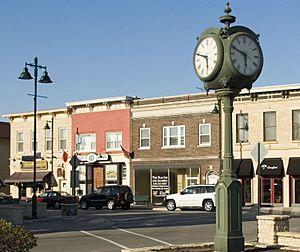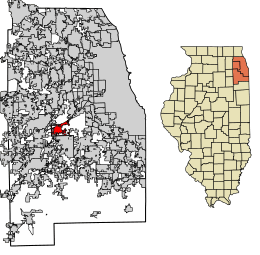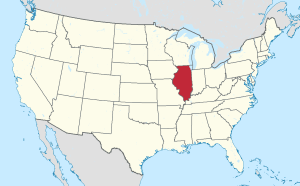Lemont, Illinois facts for kids
Quick facts for kids
Lemont, Illinois
|
|
|---|---|
| Village of Lemont | |

Budnik Plaza clock and Stephen Street facades in historic downtown Lemont
|
|
| Etymology: From French for "The Mount" | |
| Motto(s):
Village of Faith, Enjoy Our Scene!
|
|

Location of Lemont in DuPage County, Illinois.
|
|

Location of Illinois in the United States
|
|
| Country | United States |
| State | Illinois |
| County | Cook, Will, and DuPage |
| Township | Lemont, Downers Grove, DuPage |
| Settled | 1836 |
| Incorporated | June 9, 1873 |
| Area | |
| • Total | 8.74 sq mi (22.64 km2) |
| • Land | 8.37 sq mi (21.67 km2) |
| • Water | 0.38 sq mi (0.97 km2) |
| Population
(2020)
|
|
| • Total | 17,629 |
| • Density | 2,107.47/sq mi (813.70/km2) |
| Time zone | UTC-6 (CST) |
| • Summer (DST) | UTC-5 (CDT) |
| ZIP Code(s) |
60439, 60490
|
| Area codes | 630/331 |
| FIPS code | 17-42795 |
| Wikimedia Commons | Lemont, Illinois |
Lemont is a village located in Cook, DuPage, and Will counties in the U.S. state of Illinois, and is a suburb of Chicago. The population was 17,629 as of the 2020 census. Lemont is home to Argonne National Laboratory and other heavy industrial sites, and has a substantial European immigrant population.
Contents
Name
Lemont was originally known as Keepataw (after a Potawatomi chief) and a post office was established in 1840 as Keepatau. After that, it was named Athens and then Palmyra. The name Lemont (literally, 'the mountain' in French) was chosen in 1850 at the suggestion of Lemuel Brown, the postmaster and justice of the peace, or perhaps by his brother Nathaniel Brown.
History
Even before white settlers came to Lemont, Native Americans traveled the Des Plaines River in birch bark canoes on trading trips between the Mississippi River and Lake Michigan. The native Potawatomi lived off the land in this area, directly using natural resources for food, shelter, clothing and medicine. In the 18th century, French voyageurs traveled down the Des Plaines River, trading Native Americans metal, beads and cloth for animal furs and changing the Native American lifestyle forever.
Established in 1836, the village of Lemont stands as one of the oldest American communities in northeastern Illinois. It is historically significant for its role in transforming the northern region of the state from a sparsely settled frontier to a commercial, agricultural, and industrial region that supplied Chicago and areas beyond with commodities. Lemont is also unique in boasting an authentic historic district that remains intact and has been continually used since the 19th century.
Both Lemont's history and architectural uniqueness connect to the Illinois and Michigan Canal (I&M Canal). Construction of the I&M Canal began in 1837 and stands as one of the last major canal undertakings in the United States (the Hennepin Canal opened in 1907). When it was completed in 1848, it provided a continuous waterway stretching from New York (through the Erie Canal, Lake Erie, Lake Huron and Lake Michigan to Chicago, then through the I&M Canal for 97 miles (156 km) entering the Illinois River at LaSalle, Illinois, to the Mississippi River, to New Orleans) to the Gulf of Mexico.
Immigrant workers, mostly Irish, settled in Lemont to work on the canal and later moved along the corridor of the canal, improving farms within the many communities that sprang up along it.
In digging, workers discovered Lemont yellow dolomite, a harder and finer grained version of limestone. This delayed digging of the canal, but was the start of the area's second industry, quarrying. By the mid-19th century, limestone quarrying took over as the main economic factor in Lemont and sustained its growth. The town's important major buildings were faced with the Lemont limestone, abundant in local quarries. Today, 38 of those buildings remain as the Lemont downtown district. Lemont limestone was used to build the Chicago Water Tower, a building that "gained special significance as one of the few buildings to survive the destructive path of the Great Chicago Fire of 1871". In the early years, this stone was known as "Athens Marble" as a nod to its place of origin. An 1859 item in the Chicago Daily Tribune had this to say: “The Athens and DesPlaines quarries, situated on the Illinois and Michigan canal, embrace 335 acres of the finest stone in the West, known as “Athens Marble”. This stone has a high reputation for color, durability and beauty, which renders it quite an article of commerce”.
Cargo and passengers were transported on the I&M until the early 20th century, when the wider, deeper Chicago Sanitary and Ship Canal was built parallel to it. The Sanitary Canal is still used today as part of the Illinois Waterway system.
Lemont's motto is "Village of Faith", and its church spires reflect the many ethnic groups who came here to quarry stone, dig the Sanitary and Ship Canal and work in other industries.
Lemont is credited with being the largest recruiting station for the Union Army during the American Civil War, and the Old Stone Church, built in 1861 of limestone, was used as a recruiting depot. It served as the Lemont Methodist Episcopal Church for 100 years, from 1861 until 1970, when it became home to the Lemont Area Historical Society. The oldest building in Lemont, it now serves as a museum and is listed on the National Register of Historic Places.
During the Civil War, Lemont was required to sign up 33 soldiers, the village recruited 293 soldiers; only 63 returned. A Lemont Civil War Memorial Committee has formed to build a statue in Memorial Park to honor Lemont's Civil War veterans.
By 1854, railroads transported goods faster than water, and the I&M became obsolete as Lemont evolved into a railroad community; the village was incorporated on June 9, 1873.
Increasingly, the canal was used to carry wastes away from Chicago. In 1900, the larger Sanitary and Ship Canal went into operation, carrying both wastes and larger, more modern barges. All use of the I&M Canal ended in 1933, with the opening of the canal's modern successor - the Illinois Waterway.
By about 1920, the quarries declined as styles changed and builders began to use Bedford limestone from Indiana and less expensive materials like concrete.
In 1984, President Ronald Reagan signed legislation establishing the Illinois & Michigan Canal National Heritage Corridor as the nation's first National Heritage Corridor. The status recognizes the historic importance of this region and the waterway that connected Lake Michigan and the Illinois River. Today, it is a 100-mile-long (160 km) cultural park between Chicago and LaSalle/Peru, representing an ongoing partnership between the public and private sectors created to achieve a successful mixture of preservation, public use and industrial activity.
Lemont is home to the Argonne National Laboratory. Sacred architecture is another strong suit of Lemont, whose skyline is dominated by two landmark religious edifices: the Hindu Temple of Greater Chicago and SS. Cyril and Methodius church in the Polish Cathedral style. Interestingly enough, both are situated on the sides of hills, giving an even more dramatic backdrop to their monumental architecture.
Tornadoes
On June 13, 1976, a few minutes after 5:00 PM, a killer tornado struck Lemont and took three lives. 23 were injured, 87 homes were destroyed and 82 more were damaged. Damage to the high school alone was estimated at $500,000. Many people reported watching neighbors' homes explode, implode, shattering before their eyes. Cited as an unusual tornado, it backed up on its path before heading North, somewhat parallel to its path of origin.
On the same day, an F5 had laid to ruins Jordan, Iowa, 250 miles (400 km) away.
On March 27, 1991, Lemont was again hit by a tornado.
Notable people
- Diablo Cody, Academy Award-winning writer of the film Juno, raised in Lemont.
- Scott Darling, goaltender for Carolina Hurricanes
- Clayton Fejedelem, safety for the Miami Dolphins and [Cincinnati Bengals].
- Coby Fleener, former tight end for the New Orleans Saints and Indianapolis Colts, born in Lemont.
- Garrett Gilkey, former NFL offensive lineman, born in Lemont.
- Steve Grand, country/rock singer.
- Tyler Jay, pitcher, first-round pick of 2015 MLB Draft.
- Michael Katzban, state legislator in Wisconsin, born in Lemont.
- Đorđe Mihailović, professional soccer player.
- David Molk, former center for the Philadelphia Eagles and San Diego Chargers.
- Jerry Taft, weathercaster for ABC 7 news in Chicago.
- Christian Vande Velde, cyclist, the fourth place 2008 Tour de France finisher, born in Lemont.
Geography
Lemont is located at 41°40′8″N 87°59′20″W / 41.66889°N 87.98889°W (41.668784, -87.988845).
According to the 2010 census, Lemont has a total area of 8.354 square miles (21.64 km2), of which 7.97 square miles (20.64 km2) (or 95.4%) is land and 0.384 square miles (0.99 km2) (or 4.6%) is water.
Demographics
| Historical population | |||
|---|---|---|---|
| Census | Pop. | %± | |
| 1880 | 2,108 | — | |
| 1900 | 2,449 | — | |
| 1910 | 2,284 | −6.7% | |
| 1920 | 2,322 | 1.7% | |
| 1930 | 2,582 | 11.2% | |
| 1940 | 2,557 | −1.0% | |
| 1950 | 2,757 | 7.8% | |
| 1960 | 3,397 | 23.2% | |
| 1970 | 5,080 | 49.5% | |
| 1980 | 5,640 | 11.0% | |
| 1990 | 7,348 | 30.3% | |
| 2000 | 13,098 | 78.3% | |
| 2010 | 16,000 | 22.2% | |
| 2020 | 17,629 | 10.2% | |
| U.S. Decennial Census | |||
As of the census of 2010, there were 16,00 people in 5,993 households residing in the village. The racial makeup of the village was 94.1% White, 0.7% African American, 0.3% Native American, 2.7% Asian, and 1.9% from two or more races. Hispanic or Latino of any race were 7.3% of the population.
Ancestries: Polish (33.7%), German (25.7%), Irish (20.8%), Italian (12.1%), English (4.5%), Lithuanian (4.1%). 15.5% of the population was foreign born. 23.4% speak a language other than English at home.
The median household income in the village was $95,221. The per capita income for the village was $44,700.
Among households, 23.8% had children under the age of 18 living with them and 18.3% had someone who was 65 years of age or older. The average household size was 2.78. Females accounted for 51.3% of the population.
Transportation
Lemont has a station on Metra's Heritage Corridor, which provides weekday rail service between Joliet and Chicago Union Station.
In 2007, the Interstate 355 tollway extension opened, providing Lemont with more direct access to the Chicago expressway system. An interchange is located on 127th Street.
Education
Lemont boasts three National Blue Ribbon Schools, recognized by the US Department of Education for excellence in student achievement. Lemont High School received the Blue Ribbon award in 2017. Saints Cyril and Methodius School received the Blue Ribbon award in 2019.
Schools located in Lemont include the following: SD113a: [1]
- River Valley Elementary School
- Oakwood Elementary School
- Old Quarry Middle School
Lemont High School - District 210: [2]
Private/Parochial Schools
- St. Alphonsus/St. Patrick: [3]
- SS. Cyril & Methodius: [4]
- Everest Academy: [5]
- Montessori School of Lemont: [6]
- Žiburėlis Lithuanian Montessori School
- Polska Szkoła Jana Pawła II Polish School
See also
 In Spanish: Lemont (Illinois) para niños
In Spanish: Lemont (Illinois) para niños

